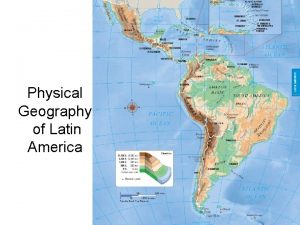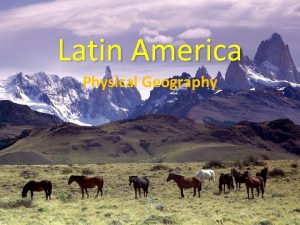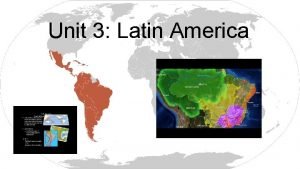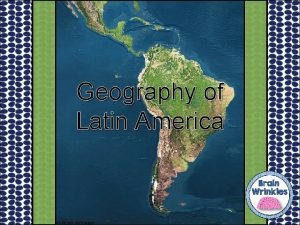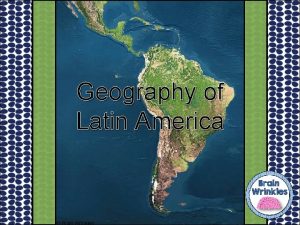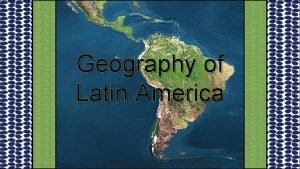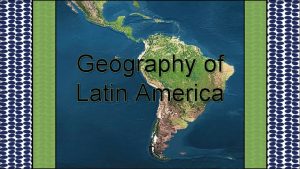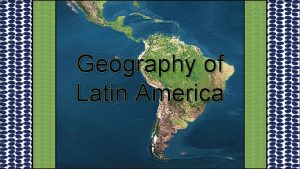Physical Geography of Latin America Climate Zones Hot









- Slides: 9

Physical Geography of Latin America Climate Zones


Hot to Mild Climate • Tropical Climates – Most of Latin America lies within the tropics – Mountain ranges and wind patterns create a variety of sub-climates – Tropical Wet • Year-round hot temps • Year-round heavy rainfall • Vast areas of rain forest – Amazon Basin shelters more species than any other place on Earth

Hot to Mild Climate • Tropical Climates – Tropical Dry climate extends over parts of: • Middle America • Most Caribbean islands • North-central South America – Savannah • Hot temperatures • Abundant rainfall • Long dry seasons

Hot to Mild Climate • Temperate Climates – South of the Tropic of Capricorn – Humid Subtropical • Dominates southern Brazil to the Pampas • Winters are short & mild • Summers are long, hot, and humid – Mediterranean • Central Chile • Dry summers & rainy winters – Marine West Coast • Southern Chile • Heavy rainfall year

Hot to Mild Climate • Dry Climates – Northern Mexico, coastal Peru & Chile, northeastern Brazil, southeastern Argentina – Grasses cover partly dry steppe lands – Cacti & hardy shrubs adapt to harsher deserts – Atacama Desert • Rain shadow of the Andes in northern Chile (Pacific coast) • One of Earth’s driest places

Hot to Mild Climate • El Niño – Strongly influences weather in South America – Changes in air pressure, temp, and rainfall – Warmer waters bring heavy flooding to Peru – Winds cause long dry seasons and crop failures in northeastern Brazil

Elevation and Climate • Altitude: A place’s height above sea level – Affects climate in specific areas – Higher altitude = cooler temperatures – The Andes have FOUR altitude zones of climate • • Sea Level to 3000 feet 3000 – 6000 feet 6000 – 10, 000 feet Above 10, 000 feet

Elevation and Climate – Terra Caliente • Hot all year • Farmers grow tropical crops – Tierra Templada • Most densely populated • Corn, citrus fruit, coffee – Tierra Fria • Forested and grassy • Potatoes, barley, wheat – Tierra Helada • Sparse vegetation • Few people
 Climate zones south america
Climate zones south america Why is latin america called latin america
Why is latin america called latin america Physical features of south america
Physical features of south america What is another arm of the atlantic ocean cradled by mexico
What is another arm of the atlantic ocean cradled by mexico Chapter 8: the physical geography of latin america answers
Chapter 8: the physical geography of latin america answers Latin america physical geography
Latin america physical geography Weather and climate crash course
Weather and climate crash course How do littoral zones differ from riparian zones?
How do littoral zones differ from riparian zones? Latin america's geography cloze notes 1
Latin america's geography cloze notes 1 Cultural geography of latin america
Cultural geography of latin america


